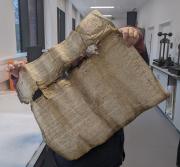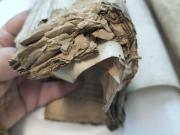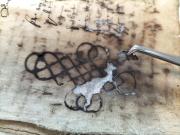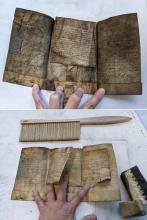Conservation of the ‘Court of Arches’ manuscript collection, 17th-19th centuries (Bbb series)
Rachel Freeman, Archivist, and Lara Artemis, Senior Conservator, write
Since its foundation in 1990, the NMCT has generously supported Lambeth Palace Library in the conservation of one of its largest archives, the Court of Arches. Through a series of grants, totalling over £90,000, we have transformed thousands of records from being unfit for consultation to being readily available for researchers.
The records of the Court of Arches are among the most important in the Archbishops’ Archives. As the court of appeal for the Province of Canterbury it was the principal ecclesiastical court of England and Wales. In its heyday, it exercised wide-ranging jurisdiction over marriage and divorce, probate, defamation, manners and morals of the clergy and laity, and non-conformity. The Court also heard numerous cases involving disputes over advowsons, churchwardens accounts, faculties, church rates, tithes and ritualism. The surviving records date largely from after the Fire of London in 1666 to the 19th century.
After legal reforms in the late 1850s, the records were discarded down a well, dug out in 1865 and transferred to the Dean of Arches’ registry at Lambeth Palace. One early 20th century Dean observed: ‘You almost needed a spade to dig the papers out of the dirt in which they were buried’. Responsibility for the collection passed to the Library in 1953, when it was clear that the archive was extensively damaged.
Involving upwards of ten conservation staff with student placements assisting, the project has dealt with a few hundred boxes of bound archives of parchment and paper records. The main conservation issues ranged from splits along the edges and the effects of inappropriate storage and handling, to severe mould damage causing loss of script as well as paper integrity. In order that we could gain a sense of levels of damage that impacted on access we categorised this into four areas, more recently described as 1) Good (slightly dirty, folds but can easily be handled); 2) fair (dirty, creases, folds and some tears but can be handled); 3) poor (dirty, torn and at risk of further damage) and 4. unfit for production (highly fragmented, many losses, desiccated seals, unable to be handled without conservation intervention).
Over the years, treatment approaches have evolved but essentially paper records were cleaned and flattened; with the additional washing and buffering (alkaline agent added) treatment process to help manage cellulose breakdown (acid hydrolysis) caused by water and subsequent mould attacks. Supporting physical loss and damage through the use of Japanese papers and wheat starch paste has been the main repair process. This has evolved to also using gelatine sizing and re-moistenable tissue techniques to help manage the impact of water on iron gall ink corrosion. Parchment records were also cleaned, humidified to ease creases around script; and repairs to these were made with goldbeaters’ skin and gelatine as adhesive, with more recent approaches including Japanese Gampi and starch paste. Wax seals were consolidated and repaired with wax as necessary.
A broad view preservation assessment survey was undertaken (2019) alongside a mould check and box clean/replacement project in readiness for moving the collection to its new space. This has enabled us to really visually engage with what has been done so far to preserve the collection, understand and compartmentalise its future preservation needs and continue to support the cataloguer. In 2021 the Library moved to a new, purpose-built building, where the conserved items are housed in a combination of polyester sleeves and sleeves and bespoke folders, and sit in archival boxes. All Lambeth Palace Library’s stores are PD 5454 compliant and were built in line with BS EN 16893: 2018.
The records that the NMCT has enabled us to conserve form part of an archive of national significance. The material is a primary source for social, biographical, economic, legal, topographical and ecclesiastical history. Unlike in a common law court, the proceedings for ecclesiastical law were conducted by written testimony not through oral evidence. The resulting body of records provides a hugely revealing window into the lives of the parties involved: scandalous relationships are unpicked, errors of belief scrutinised and riotous behaviour condemned.
The variety of the contents is best conveyed by some examples:
Most of the documents generated by the medieval Court have not survived, but some unexpectedly early items appear in later cases: the Fineshade Cartulary (Arches Ff 291) was conserved with an NMCT grant in 1996 and had been submitted as evidence in a case in 1672. The case used the 14th-century cartulary in a dispute concerning the payment of church rate to Blatherwycke Church in Northamptonshire. Arches series G, the ‘Small Exhibits’ series in which the cartulary sits, hosts an eclectic mix of items produced as evidence and, had they not been, it is likely that many of these records would not have survived to the present day.
Series G (‘Papers Exhibited’) was conserved with funds granted in 2003. Characters to be found in these records range from George III’s son, Augustus Frederick – whose marriage was annulled by the court in 1795 – to Lodowicke Muggleton, co-founder of Muggletonianism. Muggleton appears as the beneficiary of the will of Thomas Hudson, an innholder of St. Botolph Aldersgate, London. The will records Muggleton as a ‘dear and most beloved friend’ and provides valuable evidence on Muggletonianism by naming others who were ‘members with me in the true faith of our Lord Jesus’.
Series Bbb, the subject of a grant made by the NMCT in 2020, contains Commissions 'in partibus' – statements made by parties unable to come to London – and it abounds with colourful personalities. The archive reveals information about groups often under-represented in archival sources from the time: the lives of hundreds of women are documented shedding light on the roles they played from tavern keepers and pawnshop owners to the mistress of a privateer. Margaret Constantine, who appears in 1714, took things a step further: the records reveal her attempts to disguise the role she played. Around the year 1701, Margaret met a Nicholas Smith, Lieutenant on the HMS Winchelsea. She subsequently came on board the ship dressed as a man and remained with the vessel for six months in men’s clothing. Margaret claimed that the couple were married, while Nicolas disputed this.
Servants are another group featuring prominently in the records. Much of the matrimonial litigation seen by the Court had already been through the local consistory courts before being heard at the Arches, making the cases vastly expensive as well as excruciatingly public. Requiring huge sums to finance, it’s not surprising that the cases are dominated by the lives of the affluent, but the records provide much detail on the relationships and working conditions of those lower down the social scale. When the Countess of Strathmore brought a case of adultery and cruelty against her husband in 1787, 38 individuals gave statements, including her butler, coachman, cook and footman. Statements often provide information on the servants’ background, wages and the nature of their work.
The archive was the subject of hundreds of reading room requests in 2023, making it one of our most sought-after sets of records. The areas of research for which it is used are diverse: the history of gestures and body language, deafness and muteness, gender identity, persecution of protestant minorities to name but a few.
To celebrate the completion of the most recent conservation work, the Library ran Moral and Material Decay: Four Centuries of the Court of Arches from July to October 2023, which, as the name suggests, explored both the characters appearing in the Court and physical records in which they are recorded. The online version can be viewed on the Lambeth Palace Library website. The Library also produced a behind-the-scenes video which explores the considerations, particularly the conservation issues, relating to the display of these records.
Lambeth Palace Library is immensely grateful to the NMCT for enabling us to make this fabulous resource available to researchers, and we look forward to many future collaborations.
All images are courtesy of Lambeth Palace Library.






